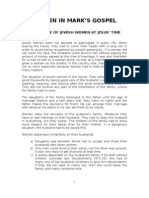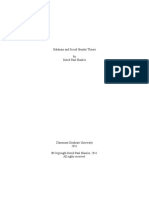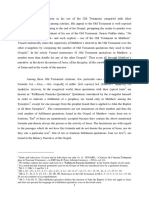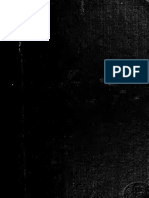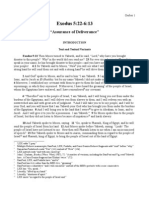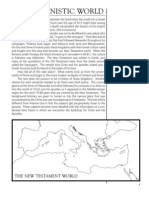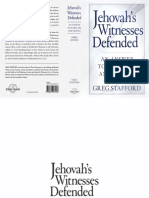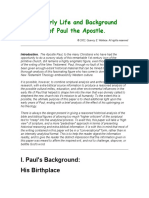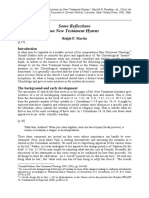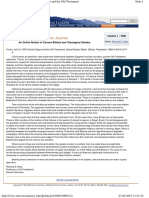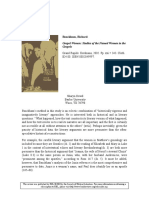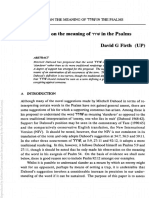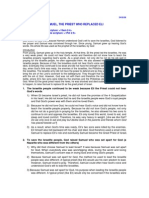Review Bauckham, Richard, Jesus and The Eyewitnesses - The Gospels As Eyewitness Testimony
Review Bauckham, Richard, Jesus and The Eyewitnesses - The Gospels As Eyewitness Testimony
Uploaded by
gersand6852Copyright:
Available Formats
Review Bauckham, Richard, Jesus and The Eyewitnesses - The Gospels As Eyewitness Testimony
Review Bauckham, Richard, Jesus and The Eyewitnesses - The Gospels As Eyewitness Testimony
Uploaded by
gersand6852Original Title
Copyright
Available Formats
Share this document
Did you find this document useful?
Is this content inappropriate?
Copyright:
Available Formats
Review Bauckham, Richard, Jesus and The Eyewitnesses - The Gospels As Eyewitness Testimony
Review Bauckham, Richard, Jesus and The Eyewitnesses - The Gospels As Eyewitness Testimony
Uploaded by
gersand6852Copyright:
Available Formats
Novum Testamentum 52 (2010) 88-100
brill.nl/nt
Book Reviews
Richard Bauckham, Jesus and the Eyewitnesses: The Gospels as Eyewitness Testimony (Grand
Rapids: Eerdmans, 2006), xiii + 538 pp., ISBN: 978-0-8028-3162-0, $ 32.00.
Advanced scholarly praise for this book has created high expectation for readers and
reviewers. Hailed as a blockbuster (J.D.G. Dunn) and a tour de force (N.T. Wright)
that shakes the foundations of a century of scholarly study of the Gospels (G. Stanton) and promises to be a pioneering work refuting old and new errors (M. Hengel).
Bauckhams thorough study of eyewitness testimony to Jesus is a major event in New
Testament studies.
Bauckhams thesis is that the gospels are based on eyewitness testimony. In the case
of the synoptics this testimony is collected and ordered by others (Mark as Peters
interpreter; Luke as presenting the testimony of those who from the beginning were
eyewitnesses and servants of the word, 1:2). The writer of John was an eyewitness who
had been with Jesus from the beginning, and who Bauckham identies as John the
elder, rather than the Apostle, the son of Zebedee (Chapter 15). This picture is argued
with a new condence in the logion of Papias and a fresh appreciation of testimony
from Polycrates and Irenaeus.
Taking his lead from the recent impressive study by Samuel Byrskog, Story as HistoryHistory as Story (2002) Bauckham assesses the Gospels against the background
of ancient historiography, particularly Polybius and Josephus, and argues that best
historical practice was to rely on eyewitness testimony (autopsy) especially where the
historian was also participant in the events (Josephus, C.Ap. 1:47, p. 120). He contends that the gospels contain just such autopsy, and points to named persons (Jairus,
Bartimaeus, Joseph of Arimathea) as participants and subsequent guarantors of the
stories in which they appear.
This picture challenges the prevailing assumption, a legacy of form criticism, that a
long period of oral transmission in the churches intervened between whatever the
eyewitnesses said and the Jesus traditions as they reached the Evangelists (240). Will
this radically dierent picture of the history of the Gospel tradition, presented by Bauckham, stand up to scrutiny?
The variation on the form critical model proposed by Kenneth Bailey has proved
attractive in recent years. Reacting to both the informal uncontrolled model (Bultmann) or the formal controlled picture (Gerhardsson) of the transmission of the
tradition, Bailey posits an informal controlled transmission theory, based on his
observation of the practice of Middle Eastern village life. In this model it is the community that exercises control rather than the ocial storyteller. For Bauckham this
Koninklijke Brill NV, Leiden, 2010
DOI: 10.1163/004810010X12577565604251
Book Reviews / Novum Testamentum 52 (2010) 88-100
89
three-fold typology is not nuanced enough. He raises questions concerning the mechanism of control and the relative balance of stability and exibility in the transmission of
Gospel tradition (258). His study shows that eyewitnesses played a more important
role in the preservation and shaping of the tradition than has hitherto been recognized.
However, in the four contrasting areas (controlled/uncontrolled, formal/informal,
xed/free, oral/written) a model already exists that has not been suciently appreciated for its relevance for the study of the development of Gospel traditions. That
model is the Old Testament or Hebrew Bible. As the word of Jesus and the word about
him became authoritative for the early church, they began to be treated with the same
regard as the scriptures. Especially in the study of xity and freedom, the variety of
textual variations and interpretive traditions of the Old Testament current in the second temple period provide something of a mechanism of control for the tradition
which the earliest Christians handed on according to the scriptures (1 Cor 15:3-7).
The xity and freedom observable in the early Christian exegesis of scripture can provide a model for the study of their preserving and shaping of the Gospel tradition.
Exploring this model or paradigm calls for a very large study, but Bauckhams work on
eyewitnesses has now set the stage for such an investigation.
Bauckham proves more than he argues. The inuence of eyewitness testimony on
the Gospel tradition could also be applied to the epistles. He notes such inuence with
regard to 1 Cor 11:23-25 (the institution of the Eucharist) as Pauline evidence of
formal transmission of the tradition, and also refers to 1 Cor 15:1-11. But there may
be more evidence to consider. What if Paul wrote rather than at
1 Cor 2:1? If this is our decision where the manuscript support is evenly-divided, then
Pauls reference to the testimony of God may have a bearing on the discussion. At least
Bauckham should have noted this important textual variant.
Also missing from the book is any reference to 2 Peter. Given Bauckhams work on 2
Peter this is surprising. Some discussion of 2 Pet 1:16-18 would have been in order. In
light of Bauckhams denitive study of eyewitness testimony in early Christianity, how
would he assess the claims in the letter we had been eyewitnesses to his majesty (1:16)
and we were with him on the holy mountain? (1:18). Granted that in 2 Peter a
dierent word is used for eyewitnesses (; cf. Luke 1:2 ). The passage,
nonetheless, has a bearing on Bauckhams discussion. His argument that several of the
we references in Johannine literature (especially John 21:24) are examples of Johannine idiomatic usage, what he calls the we of authoritative testimony, is most persuasive (370-383). Is not this characterization equally applicable to 2 Pet 1:16-18?
Will Bauckhams pioneering work on eyewitness testimony challenge him to re-assess
his view of the letter as pseudepigraphal, in the literary genre of testament?
This book very eectively challenges old assumptions, answers old questions and
raises new ones. Bauckham explores the area of memory theory (Chapter 13) and
relates his ndings to holocaust testimony with considerable daring (Chapter 18). His
argument does not depend on these explorations and will stand long after new theories
have arisen to replace the current ones. The heart of the book is a solid advance in the
study of the Gospels with which all subsequent studies will have to reckon.
Peter R. Rodgers
You might also like
- Age of Aisha The Criticisms EndedDocument54 pagesAge of Aisha The Criticisms Endedskankhunt42No ratings yet
- Review Barnett, Paul, Paul - Missionary of Jesus (After Jesus 2)Document6 pagesReview Barnett, Paul, Paul - Missionary of Jesus (After Jesus 2)gersand6852No ratings yet
- Proverbs From Around The WorldDocument20 pagesProverbs From Around The WorldHarshit SinghalNo ratings yet
- Unity in The Fourth GospelDocument9 pagesUnity in The Fourth Gospelmichael olajideNo ratings yet
- The Muslim World Volume 70 Issue 2 1980 (Doi 10.1111/j.1478-1913.1980.Tb03405.x) Mahmoud M. Ayoub - Towards An Islamic Christology, II - The Death of Jesus, Reality or DelusionDocument31 pagesThe Muslim World Volume 70 Issue 2 1980 (Doi 10.1111/j.1478-1913.1980.Tb03405.x) Mahmoud M. Ayoub - Towards An Islamic Christology, II - The Death of Jesus, Reality or DelusionNițceVali100% (2)
- James 4.5 and The Jealous SpiritDocument18 pagesJames 4.5 and The Jealous SpiritJohnny Hanna0% (1)
- Review Beale, Gregory K., The Temple and The Church's Mission - A Biblical Theology of The Dwelling Place of GodDocument3 pagesReview Beale, Gregory K., The Temple and The Church's Mission - A Biblical Theology of The Dwelling Place of Godgersand6852100% (1)
- Dever, William G., Who Were The Early Israelites and Where Did They Come FromDocument2 pagesDever, William G., Who Were The Early Israelites and Where Did They Come Fromgersand68520% (1)
- Review Chisholm, Robert B. JR.,, Handbook On The Prophets - Isaiah, Jeremiah, Lamentations, Ezekiel, Daniel, Minor ProphetsDocument2 pagesReview Chisholm, Robert B. JR.,, Handbook On The Prophets - Isaiah, Jeremiah, Lamentations, Ezekiel, Daniel, Minor Prophetsgersand68520% (1)
- Review Campbell, Constantine R., Basics of Verbal Aspect in Biblical GreekDocument3 pagesReview Campbell, Constantine R., Basics of Verbal Aspect in Biblical Greekgersand6852100% (2)
- Ziyarat AminullahDocument27 pagesZiyarat AminullahAleksandar DragovicNo ratings yet
- Justin Martyr's Use of The Old Testament. David AuneDocument10 pagesJustin Martyr's Use of The Old Testament. David AuneDavid BaileyNo ratings yet
- Goulder - James, Brother of Jesus by Pierre-Antoine Bernheim John BowdenDocument2 pagesGoulder - James, Brother of Jesus by Pierre-Antoine Bernheim John BowdenPaul TobinNo ratings yet
- Augustine and The Manichaeans Their ChurDocument26 pagesAugustine and The Manichaeans Their ChurJuan Manuel La RosaNo ratings yet
- Anselm TormedaDocument3 pagesAnselm TormedaAmante de JesusNo ratings yet
- Jesus, Paul, Luke-Acts, and 1 Clement: Studies in Class, Ethnicity, Gender, and OrientationFrom EverandJesus, Paul, Luke-Acts, and 1 Clement: Studies in Class, Ethnicity, Gender, and OrientationNo ratings yet
- Ebionites: 2 HistoryDocument11 pagesEbionites: 2 HistoryRene SarmientoNo ratings yet
- Do Jews Have Dealings With Samaritans SV 76 2011Document31 pagesDo Jews Have Dealings With Samaritans SV 76 2011Anonymous Ipt7DRCRDNo ratings yet
- Protoevangelho Tiago IslamDocument31 pagesProtoevangelho Tiago IslamCrossamania100% (1)
- 03 Recent Pauline StudiesDocument12 pages03 Recent Pauline StudiesKHAI LIAN MANG LIANZAW100% (1)
- South Asia Institute of Advanced Christian StudiesDocument4 pagesSouth Asia Institute of Advanced Christian StudiesPauline KutNo ratings yet
- Casey: Critical GodDocument9 pagesCasey: Critical GodOlestar 2023-06-22No ratings yet
- Jewish Sects PDFDocument2 pagesJewish Sects PDFshishankisNo ratings yet
- Alphonse MinganaDocument56 pagesAlphonse Minganajsounggun100% (1)
- IS505 Lecture 2 The Development of Early Islam According To The Neo Revisionists 600 750Document97 pagesIS505 Lecture 2 The Development of Early Islam According To The Neo Revisionists 600 750Daniel IndrawanNo ratings yet
- Keith Small Quranic Window New Testament Textual HistoryDocument7 pagesKeith Small Quranic Window New Testament Textual HistoryseanaseymourNo ratings yet
- Women in Mark's GospelDocument12 pagesWomen in Mark's GospelgregnasNo ratings yet
- Interpretation History of The Good SamaritanDocument8 pagesInterpretation History of The Good SamaritanBraden CampbellNo ratings yet
- Luther Vs UOJ PDFDocument183 pagesLuther Vs UOJ PDFwienslaw5804No ratings yet
- The Theology of Khurpui-A Komrem Theological Implication On RedemptionDocument4 pagesThe Theology of Khurpui-A Komrem Theological Implication On RedemptionEmmanuel Serto50% (2)
- Paul and The LawDocument4 pagesPaul and The LawAlberto HernandezNo ratings yet
- PHD - Galatians and Social Identity Theory PDFDocument250 pagesPHD - Galatians and Social Identity Theory PDFVladimir GorbenkoNo ratings yet
- The Cappadocian Distinction Between Person and Nature and Its ImpDocument11 pagesThe Cappadocian Distinction Between Person and Nature and Its ImpCornel-Georgian DinicăNo ratings yet
- An Introduction To Second Temple JudaismDocument43 pagesAn Introduction To Second Temple JudaismJaime Toledo100% (2)
- Fulfillment Quotations Introduction: Chapter 1Document13 pagesFulfillment Quotations Introduction: Chapter 1mertoos100% (1)
- Feminist Perspectives On Mission and MinistryDocument5 pagesFeminist Perspectives On Mission and Ministrytripurajoseph18No ratings yet
- St. Paul, A Study in Social and Religious History, Adolf Deissman. (1912)Document350 pagesSt. Paul, A Study in Social and Religious History, Adolf Deissman. (1912)David Bailey100% (2)
- Frymer Kensky-Reading Rahab PDFDocument11 pagesFrymer Kensky-Reading Rahab PDFJonathan100% (2)
- Review Essay by Thielman of Yarbrough's Salvation Historical FallacyDocument6 pagesReview Essay by Thielman of Yarbrough's Salvation Historical Fallacykansas07No ratings yet
- A Syriac Dialogue Between Joseph and Benjamin: Sebastian BrockDocument13 pagesA Syriac Dialogue Between Joseph and Benjamin: Sebastian BrockThiago RORIS DA SILVANo ratings yet
- Philip R Davies The History of Ancient IDocument3 pagesPhilip R Davies The History of Ancient ISeira NanamiNo ratings yet
- Expositional Exegesis of Exodus 5:22-6:13Document13 pagesExpositional Exegesis of Exodus 5:22-6:13Jacob D. Gerber67% (3)
- Ambassadors of ReconciliationDocument10 pagesAmbassadors of ReconciliationlbrechtNo ratings yet
- 20 Early Islam An Alternative Scenario of Its Emergence - Korr Markus1Document34 pages20 Early Islam An Alternative Scenario of Its Emergence - Korr Markus1Gruz Fruz100% (1)
- Jan Heilmann. "A Meal in The Background of John 6:51-58?"Document21 pagesJan Heilmann. "A Meal in The Background of John 6:51-58?"JonathanNo ratings yet
- Handouts #4 2.2. Development of "Low Christology" and "High Christology" High Christology Vs Low ChristologyDocument8 pagesHandouts #4 2.2. Development of "Low Christology" and "High Christology" High Christology Vs Low ChristologyChristian Fel Moralita100% (1)
- Biblical AntiquityDocument16 pagesBiblical Antiquityomegalink123No ratings yet
- The Letter To GalatiansDocument10 pagesThe Letter To Galatiansreverend_gicaNo ratings yet
- Prophet Muhammad Was A LooterDocument3 pagesProphet Muhammad Was A LooternoasNo ratings yet
- Gospel: According To MarkDocument16 pagesGospel: According To MarkDea Gamara100% (1)
- Belonging in The TempleDocument10 pagesBelonging in The TempleScott TaylorNo ratings yet
- The Identity of The Little Horn in Daniel 8: Antiochus Iv Epiphanes, Rome, or The Antichrist?Document12 pagesThe Identity of The Little Horn in Daniel 8: Antiochus Iv Epiphanes, Rome, or The Antichrist?Jsb FerreiraNo ratings yet
- Islam Historical, Social and Political PerspectivesDocument452 pagesIslam Historical, Social and Political PerspectivesJohn AlphaNo ratings yet
- Apostolic FathersDocument5 pagesApostolic FathersRene SarmientoNo ratings yet
- Jehovah's Witnesses Defended: An Answer To Scholars and Critics, Greg Stafford Takes Up The Familiar DefenseDocument12 pagesJehovah's Witnesses Defended: An Answer To Scholars and Critics, Greg Stafford Takes Up The Familiar DefenseMattops TVNo ratings yet
- Ware - Equal in Essence Distinct in RolesDocument16 pagesWare - Equal in Essence Distinct in Roleskaging malabago100% (1)
- Fred Doner ReadingDocument18 pagesFred Doner ReadingZayd KhanNo ratings yet
- Augustine and MartyrsDocument15 pagesAugustine and MartyrsNaveed MansooriNo ratings yet
- A Research Article On Understanding John 1-1Document12 pagesA Research Article On Understanding John 1-1iriseightyninet100% (1)
- Archaeology & The Book of ActsDocument14 pagesArchaeology & The Book of ActsVern PetermanNo ratings yet
- Apocalypticism As A Worldwiew by Collins PDFDocument17 pagesApocalypticism As A Worldwiew by Collins PDFLAURENCE RYAN MATANo ratings yet
- Bible Handbook of MigrationDocument16 pagesBible Handbook of MigrationSamuel Adjei100% (1)
- 2003 - Craig A. Evans - Jewish Versions of The Gospel of Matthews. Observations On Three Recent PublicationsDocument12 pages2003 - Craig A. Evans - Jewish Versions of The Gospel of Matthews. Observations On Three Recent Publicationsbuster301168100% (1)
- Roma 2 PDFDocument116 pagesRoma 2 PDFHendra Gultom GultomNo ratings yet
- The Early Life and BackgroundDocument15 pagesThe Early Life and Backgroundteachile-1100% (1)
- Some Reflections On New Testament Hymns: Ralph P. MartinDocument11 pagesSome Reflections On New Testament Hymns: Ralph P. Martincruzver100% (2)
- Review Bird, Michael F., Jesus and The Origins of The Gentile MissionDocument3 pagesReview Bird, Michael F., Jesus and The Origins of The Gentile Missiongersand6852No ratings yet
- Review Bird, Michael F., Crossley James, How Did Christianity BeginDocument4 pagesReview Bird, Michael F., Crossley James, How Did Christianity Begingersand6852No ratings yet
- Review Baum, Armin D.,Der Mündliche Faktor Und Seine Bedeutung Für Die Synoptische FrageDocument4 pagesReview Baum, Armin D.,Der Mündliche Faktor Und Seine Bedeutung Für Die Synoptische Fragegersand6852No ratings yet
- Review Bird, Michael F., The Saving Righteousness of God - Studies On Paul Justification and The New PerspectiveDocument7 pagesReview Bird, Michael F., The Saving Righteousness of God - Studies On Paul Justification and The New Perspectivegersand6852100% (2)
- Review Grant Robert M. Eusebius As Church Historian (JR)Document3 pagesReview Grant Robert M. Eusebius As Church Historian (JR)gersand6852No ratings yet
- Review Baum, A.D., Pseudepigraphie Und Literarische Fälschung Im Frühen ChristentumDocument2 pagesReview Baum, A.D., Pseudepigraphie Und Literarische Fälschung Im Frühen Christentumgersand6852No ratings yet
- Review Currid, John D., Ancient Egypt and The Old TestamentDocument1 pageReview Currid, John D., Ancient Egypt and The Old Testamentgersand6852No ratings yet
- Review Alexander, T. Desmond, Rosner, Brian (HRSG.) New Dictionary of Biblical TheologyDocument4 pagesReview Alexander, T. Desmond, Rosner, Brian (HRSG.) New Dictionary of Biblical Theologygersand6852No ratings yet
- Review Bauckham, Richard, Gospel WomenDocument3 pagesReview Bauckham, Richard, Gospel Womengersand6852No ratings yet
- Review Cowan, Steven (HRSG.), Five Views of ApologeticsDocument2 pagesReview Cowan, Steven (HRSG.), Five Views of Apologeticsgersand6852100% (1)
- Review Bauckham, Richard, Jesus and The Eyewitnesses - The Gospels As Eyewitness TestimonyDocument6 pagesReview Bauckham, Richard, Jesus and The Eyewitnesses - The Gospels As Eyewitness Testimonygersand6852No ratings yet
- Review Bauckham, Richard, God CrucifiedDocument4 pagesReview Bauckham, Richard, God Crucifiedgersand685250% (2)
- Review Anderson, Paul N., E.A. (HRSG.), John, Jesus and History Vol.1 - Critical Appraisals of Critical ViewsDocument5 pagesReview Anderson, Paul N., E.A. (HRSG.), John, Jesus and History Vol.1 - Critical Appraisals of Critical Viewsgersand6852100% (1)
- DeSilva, David A., Seeing Things John's Way - The Rhetoric of The Book of RevelationDocument2 pagesDeSilva, David A., Seeing Things John's Way - The Rhetoric of The Book of Revelationgersand6852No ratings yet
- Denver Journal: An Online Review of Current Biblical and Theological StudiesDocument2 pagesDenver Journal: An Online Review of Current Biblical and Theological Studiesgersand6852No ratings yet
- Denver Journal: An Online Review of Current Biblical and Theological StudiesDocument2 pagesDenver Journal: An Online Review of Current Biblical and Theological Studiesgersand6852No ratings yet
- Review Brueggemann, Walter, Theology of The Old Testament - Testimony Dispute AdvocacyDocument2 pagesReview Brueggemann, Walter, Theology of The Old Testament - Testimony Dispute Advocacygersand6852No ratings yet
- Review Bauckham, Richard (HRSG.), The Gospels For All Christians - Rethinking The Gospel AudiencesDocument2 pagesReview Bauckham, Richard (HRSG.), The Gospels For All Christians - Rethinking The Gospel Audiencesgersand6852No ratings yet
- Bauckham Richard The Testimony of The Beloved Disciple-Narrative History and Theology in The Gospel of John PDFDocument2 pagesBauckham Richard The Testimony of The Beloved Disciple-Narrative History and Theology in The Gospel of John PDFgersand6852No ratings yet
- Review Brown, Raymond, An Introduction To The New TestamentDocument2 pagesReview Brown, Raymond, An Introduction To The New Testamentgersand6852No ratings yet
- Review Witherington, Ben, The Paul Quest - The Renewed Search For The Jew of TarsusDocument2 pagesReview Witherington, Ben, The Paul Quest - The Renewed Search For The Jew of Tarsusgersand6852No ratings yet
- Latter RainDocument8 pagesLatter RainschneestoffNo ratings yet
- BRS 22.0 Prison Epistles-6!26!12Document56 pagesBRS 22.0 Prison Epistles-6!26!12jborjas001100% (1)
- Christ YouthDocument217 pagesChrist YouthG John Thimothy100% (1)
- What Is Your IsaacDocument22 pagesWhat Is Your IsaacJohn Rexel CaroNo ratings yet
- Alfred Acton SWEDENBORG's MEMORABILIA Some Little Known Facts New Church Life March 1953Document21 pagesAlfred Acton SWEDENBORG's MEMORABILIA Some Little Known Facts New Church Life March 1953francis battNo ratings yet
- How Great Is Our GodDocument5 pagesHow Great Is Our GodHa NnaNo ratings yet
- Amazing Grace1 PDFDocument1 pageAmazing Grace1 PDFArlen DutuNo ratings yet
- Thoughts On Divorce & RemarriageDocument23 pagesThoughts On Divorce & RemarriageJohn FehlenNo ratings yet
- Committal Rite: Opening Hymn: I Was There To Hear Your Borning Cry (Ylvisaker)Document3 pagesCommittal Rite: Opening Hymn: I Was There To Hear Your Borning Cry (Ylvisaker)klein emperadoNo ratings yet
- History and Commentary On KING BELSHAZZARDocument4 pagesHistory and Commentary On KING BELSHAZZAREssel AnnorNo ratings yet
- 978 1 907534 56 0 - HB - Int PDFDocument374 pages978 1 907534 56 0 - HB - Int PDFDaniel MartinsNo ratings yet
- Slavonic Vita Adae Et EvaeDocument4 pagesSlavonic Vita Adae Et EvaeAnonymous PGDSQlFNo ratings yet
- Chanukkah Messianic Candle Lighting CeremonyDocument5 pagesChanukkah Messianic Candle Lighting CeremonyCongregation Shema Yisrael100% (3)
- A Note On The Meaning of 'Sarara' in The PsalmsDocument10 pagesA Note On The Meaning of 'Sarara' in The PsalmsBimo Setyo UtomoNo ratings yet
- O Remember Learn Wisdom in Thy YouthDocument24 pagesO Remember Learn Wisdom in Thy Youthcarolyn_hendryNo ratings yet
- A Biblical Explanation of The MassDocument4 pagesA Biblical Explanation of The MassWilliam A. Kissenberger Jr.100% (1)
- Samuel, The Priest Who Replaced EliDocument2 pagesSamuel, The Priest Who Replaced Elilifechurch100% (3)
- Eliezer Segal-In Those Days, at This Time Holiness and History in The Jewish Calendar (2008) PDFDocument345 pagesEliezer Segal-In Those Days, at This Time Holiness and History in The Jewish Calendar (2008) PDFBeBent100% (1)
- Hosea 4:6: Israelite Ignorance: Cross ReferencesDocument4 pagesHosea 4:6: Israelite Ignorance: Cross ReferencesEYE EYENo ratings yet
- Terjemah Jalaul AfhamDocument2 pagesTerjemah Jalaul AfhamHermawan Sopi NugrahaNo ratings yet
- Boyarin - A Radical Jew - Paul and The Politics of IdentityDocument256 pagesBoyarin - A Radical Jew - Paul and The Politics of Identityvarnamala100% (1)
- Tarot History and 22 Major ArcanaDocument31 pagesTarot History and 22 Major ArcanaCristi Gulin100% (2)
- AP Lang Q2 - 1996 Gary Soto StealingDocument1 pageAP Lang Q2 - 1996 Gary Soto StealingHolly CampbellNo ratings yet
- The Tabernacle As Structurally Akin ToDocument19 pagesThe Tabernacle As Structurally Akin ToHT CasaNo ratings yet
- North Jersey Jewish Standard, January 2, 2015Document44 pagesNorth Jersey Jewish Standard, January 2, 2015New Jersey Jewish StandardNo ratings yet
- Aelfric's PrefaceDocument1 pageAelfric's PrefaceAva PascalNo ratings yet
- Watchtower: Quotes About 1975Document22 pagesWatchtower: Quotes About 1975sirjsslutNo ratings yet
- Childrens CampDocument7 pagesChildrens CampJane Sarah ChelliahNo ratings yet


























